Blog
August 22nd, 2012
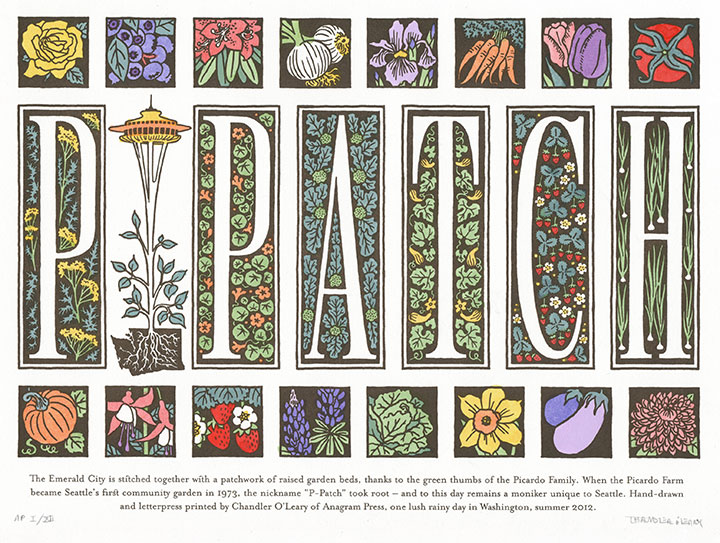
A couple of months ago I was asked to create a letterpress broadside for a collaborative print portfolio for a show in Asheville, put together by the Ladies of Letterpress. The theme was Expanding Communities—beyond that, we could do anything we wanted. So I focused on a unique element of Seattle’s community: the P-Patch.
A P-Patch is a community garden like any other—and completely unlike any other. The name comes from the Picardo family, who converted their farm into the city’s first truly communal garden in the 1970s. So to this day, if you life in Seattle, you tend your p-patch, not your garden plot. That just charmed the heck out of me, and I wanted to create a tribute to it.
P-Patch is completely hand-lettered, as well as hand-painted with watercolor, in homage to the hard work required to maintain a thriving garden. Many thanks to the Ladies of Letterpress gals for inviting me to be a part of the portfolio—I can’t wait to see what everyone else came up with!
July 6th, 2012
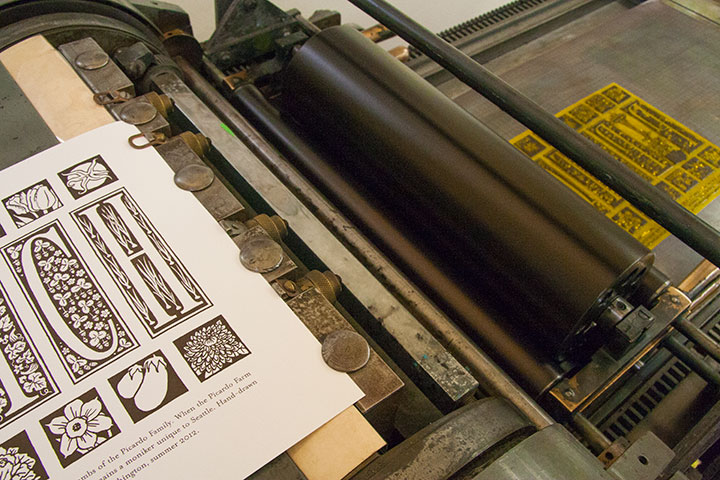
I’m working on a little something in Jessica’s studio right now.
Something that’s making me downright hungry.
I’ll show you the finished product as soon as it’s done—provided I don’t go bury my head in the veggie crisper first!
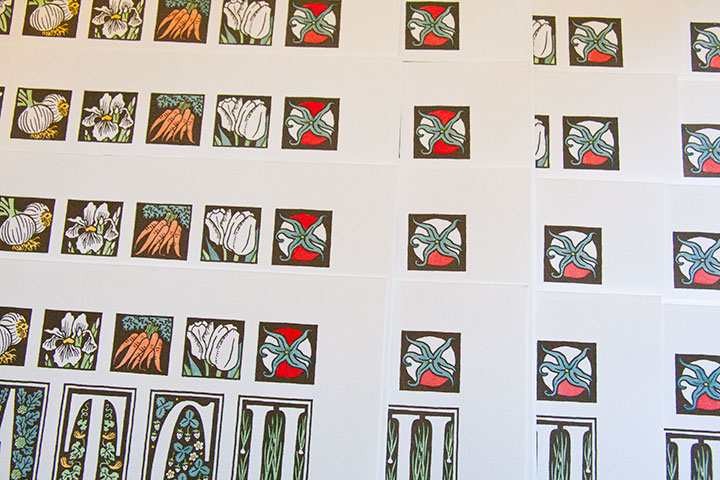
June 29th, 2012
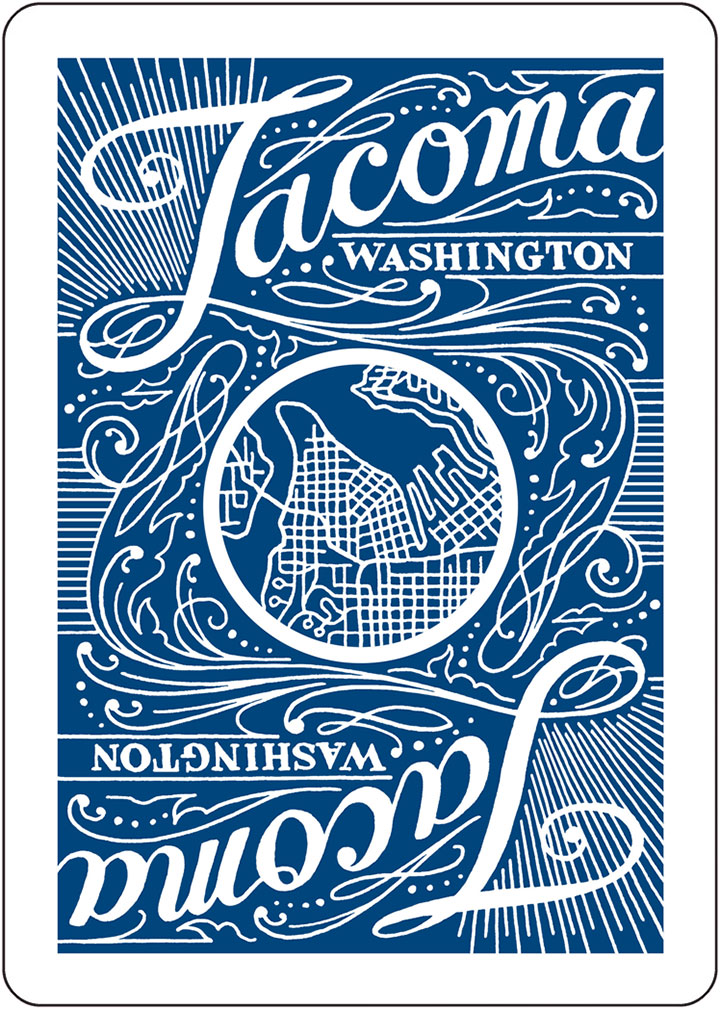
My brain is chock full of useless information—I could sing you about 35,000 ad jingles on key, or recite Jurassic Park or Trading Places or a hundred other movies line-for-line. But don’t challenge me to a game of Poker, because I have a terrible head for card games. I love playing them, and am always up for learning when friends come over a suggest a rubber of something or other. The trouble is, I forget the rules right away—so whenever I sit down to a rematch, it’s like starting at square one.
As an example, I used to do summer stock theatre, and we techies had a tradition of playing Hearts backstage during the sound check. So I played Hearts every night for two months straight, three summers in a row, and I still can’t remember the rules now. (Something about being saddled with the Queen of Spades, and lots of half-joking shouted epithets surrounding that card, but that’s about it.)
Over the years I have learned and forgotten dozens of card games—including Snap, President, Pitch, Five Card Draw, Seven Card Stud, Crazy Eights, Kings Corners, Egyptian Ratscrew, Spades, Slapjack, Pig, Cheat, Five Hundred, Hand & Foot, Whist—and probably plenty of others that I’ve even forgotten the name for.
About the only games I can ever keep in my head are the embarrassingly simple ones like War, Go Fish, Old Maid and Blackjack. Oh, and I can play Cribbage like a fiend, because my dad and his Scottish friend Alex taught me when I was nine or ten. We used to have hilariously cutthroat wee-lass-vs.-grown-man Cribbage tournaments on a regular basis, so how could I ever forget that?
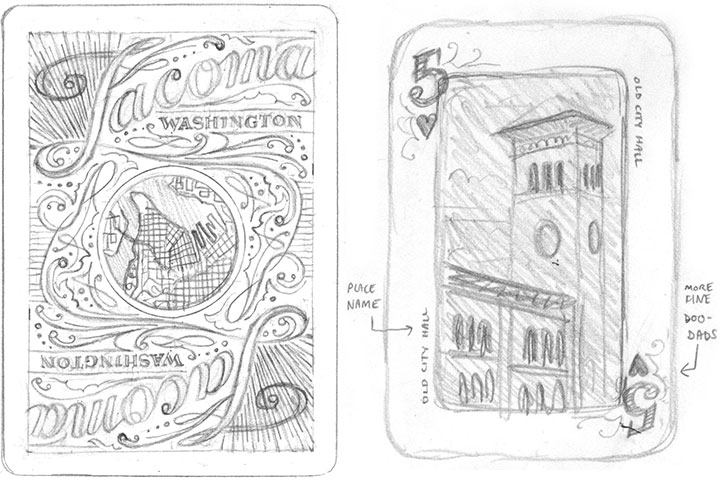
Being lousy at remembering any card games, however, hasn’t stopped me from wanting to design a card game. Or collecting interesting or unusual decks (the Tailor and I have a good dozen in regular rotation). So when my friends Maija and Amy asked me to be the designer on the poker deck they were dreaming up, I think must have freaked them out by shouting, “YES!” before they’d even finished their sentence.
(And as an added bonus, I got first dibs on my favorite Tacoma haunts.)
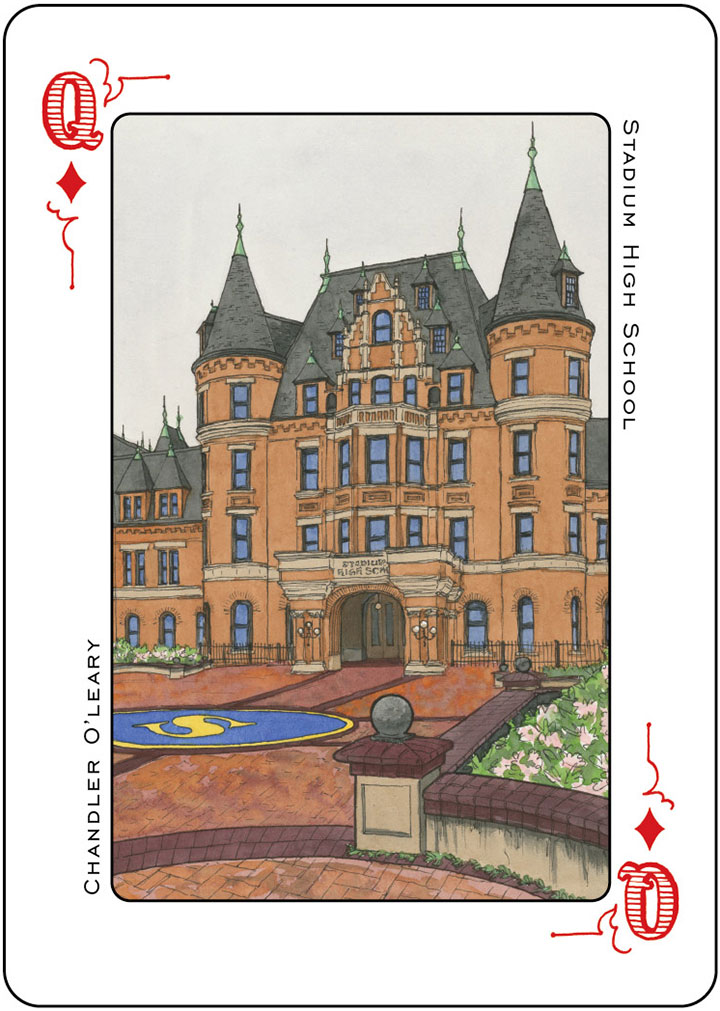
These gals weren’t looking for any old run-of-the-mill card deck, either. They wanted to show off Tacoma in all her architectural splendor. And since we’re blessed with a veritable boatload of fabulously talented artists in this town, they decided to divvy up the deck by ranks—with fourteen artists, each tackling a list of locations in four-of-a-kind fashion. I loved being the first to see the collection of incredible artwork come down the pike from these folks. Everybody involved in the project has gone above and beyond our wildest imagination—I can’t wait to see the finished deck.

Beyond just creating something beautiful and fun, Amy and Maija have their eyes on a bigger prize. They want to create a real, no-kidding Tacoma souvenir. We get a lot of visitors and tourists around here, what with the Sound and the Mountain and the Universities and what-have-you—but you’d be hard-pressed to find Tacoma-specific tchotchkes (or even postcards!) that aren’t sarcastic. And I know I’m not the only one around here who’s a little tired of folks knockin’ T-town, based solely on a stereotype and a thirty-year-old reputation. So we’re upping the ante a little, and offering a bit of hard evidence that Tacoma is pretty dern great.
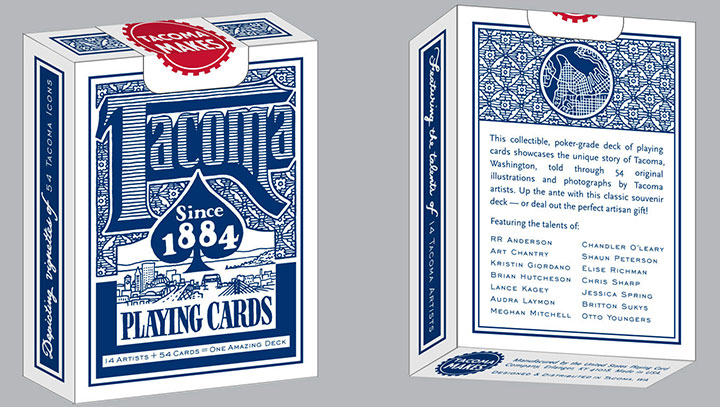
You know my schtick by now, so you can guess that all the lettering and pattern doo-dads are hand-drawn. I had the pleasure of designing the suits, rank typography, card face template, card backs and box.
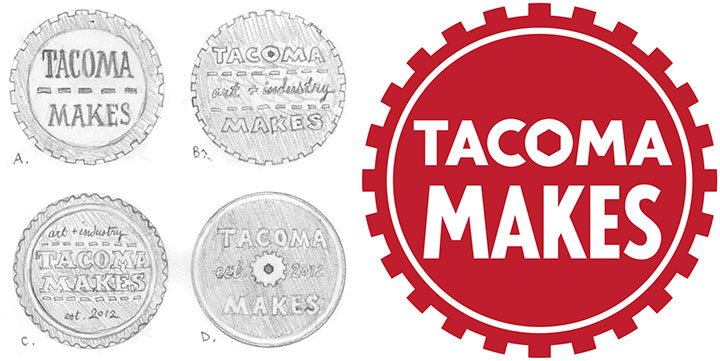
I even got to design the logo for Maija and Amy’s company, Tacoma Makes. Basically, it was the kind of project I’m always on the lookout for, but which rarely lands in my lap. So I spent about half of the time grinning my fool head off, and the other half pinching myself in disbelief.

I also got to flex my file-production muscles. I love to geek out over the technical side of design, but since I started my business, much of my production work has centered around letterpress printing. So playing with dielines and spot color swatches again was a nice little challenge.
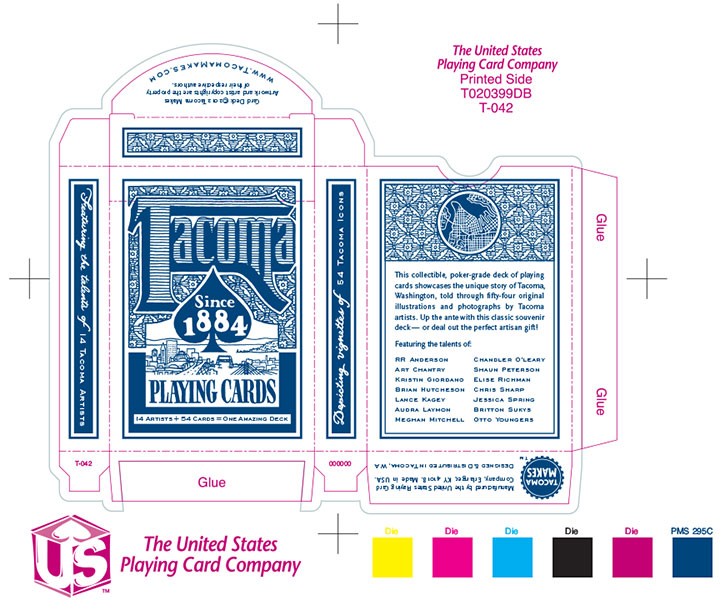
We’re taking all these extra steps because this is a real, bona fide, professional-grade poker deck. The kind folks at the U.S. Playing Card Company are manufacturing the cards for us—they’re the people behind the Bicycle, Bee, Hoyle and other card brands. So you won’t have to hedge your bets that this deck will be extra tasty.

To raise funds for the card printing, and even pay for modest artist contracts, we set up a Kickstarter project (much like the Apocalypse Calendar that you all so graciously funded last year). Now normally this would be where I explain that Kickstarter projects are only funded if they reach their entire monetary goal by the deadline—but I don’t have to! I left town for a few days, just after the project launch, with the intention of spreading the word when I got home. So imagine how floored I was to come back and discover that we’d met our goal in just six days!
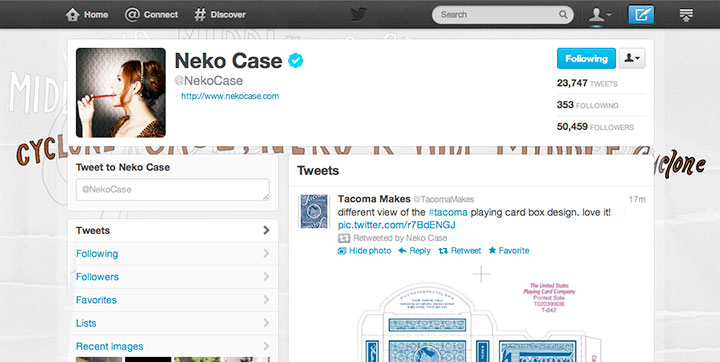
The response to this has been staggering. And it’s not only the lovely legions of fellow Tacomans who have supported us—we’re seeing pledges come in from all over the country. And as a nerdy fan-girl aside, I just have to squeal and tell you that Neko Freaking Case (a hometown Tacoma gal) has been retweeting my designs in the Twitterverse. Dorky internet hero fantasy: fulfilled, folks.

The Kickstarter project will run through July 19, so you can still contribute if you want to get in on rewards and goodies that are only available to backers. Otherwise, the cards will be in hand and dealt out this November—along with an exhibition of all the original artwork.
There’s even a rumor of an artist game night in the works, so cut the cards! I’m up for any game you’re willing to teach me—as long as you don’t mind that I’ll probably forget the rules before the night is through.
In the meantime, thank you so much for all your support for our crazy card deck! I’ve said it before, and I’ll say it again—Tacomans (and honorary Tacomans!) are the best folks on earth.
• • • • • • • • • • • • • • • • • • • • • • • • • • • • • • • • • • • • • • • • • • • • • • • • • • • • • • • • • • • •
Edited to add (fall 2013): The blue deck has been so popular that we have done a red deck as a sequel! The new deck features all new artwork and artists—you can read more about it here.

June 20th, 2012

I’m helping some friends of mine cook up a big ol’ basket of hometown pride. That’s all I’ll say for now, but we’ll be ready to spill the beans next week.
It’ll be worth the wait, I promise.
June 13th, 2012
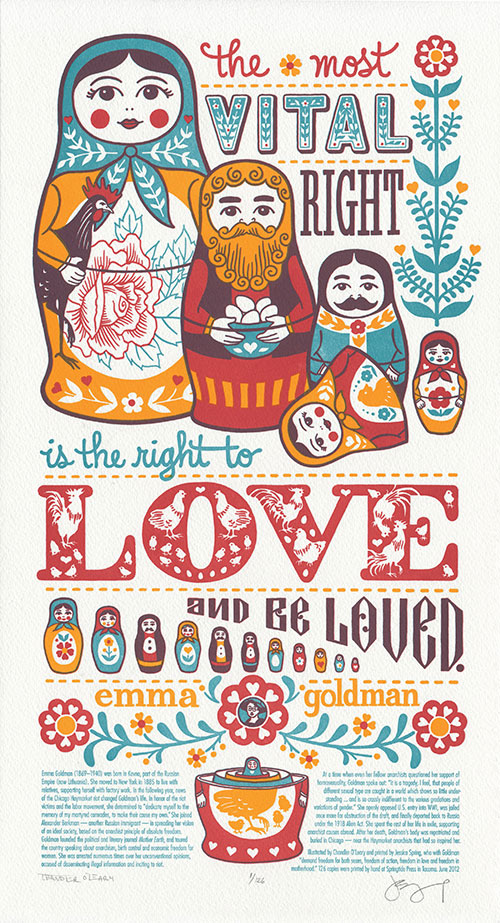
If you happen to live in Washington state, you can’t help but notice that love is in the air. It’s not quite what you think, though—rather than turtledoves and cupids flying around, the breeze is carrying ballot petitions and angry voices.
Though Washington became the seventh U.S. state to legalize same-sex marriage earlier this year, opponents forced a voter referendum to decide the issue this November. So while we’d rather just toast our friends and their families, we’ve got to put up our dukes first.
Already tempers are running high, and everyone seems to be up in arms—it’s total anarchy out there. So we thought, who better to talk to than an anarchist?
The most vital right is the right to love and be loved. —Emma Goldman
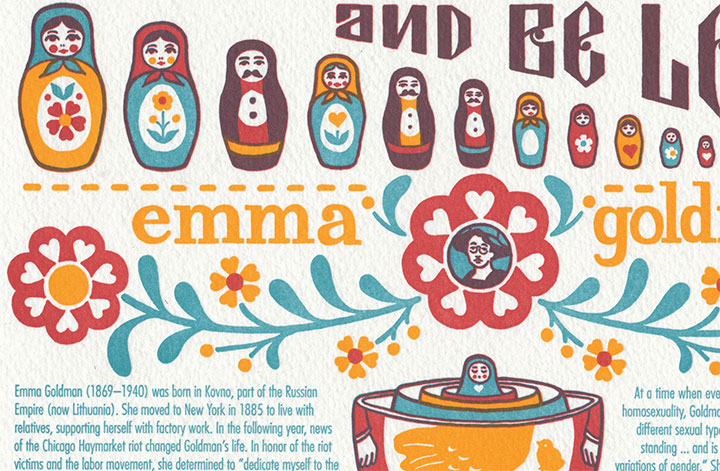
Huh. Pretty down-to-earth for an anarchist, actually. Especially if you consider some of the other things Emma’s said in the past.
I think that if we could somehow put all the ladies we’ve featured previously into a room together, they might end up killing each other (good thing they’re already dead, eh?). They all had such different ideologies and passions that I can’t imagine all fourteen of them agreeing on any one thing. But I’m fairly sure they’d be united over Emma—in thinking she was a complete weirdo, that is. (Sorry, Emma.)
Yet for all her outlandish creeds and fierce opinions, her thoughts on families, love and motherhood cut straight to the heart of the matter. And that’s what drew us to her.
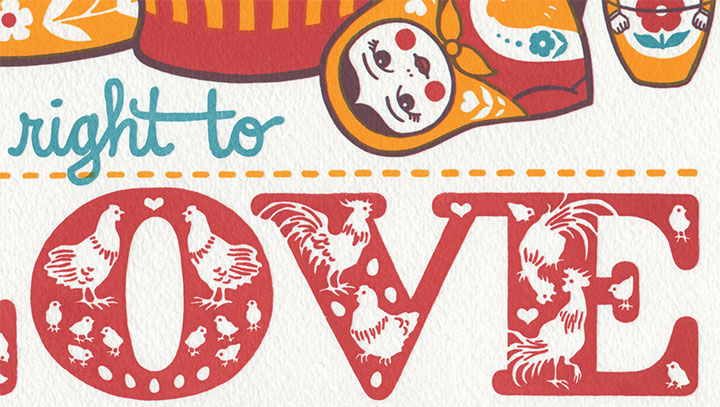
To pay homage to Emma’s folksy words, we turned to folk art for inspiration. (Get out your grandma’s Pyrex and raise a glass!) Love Nest is dominated by a lively brood of nesting matryoshka dolls. Each individual is different, but together they complete the picture of a nurtured, multicolor family. Roosters, hens and chicks complete the flock waiting for the next generation to hatch as Emma’s words stitch the family together.
To support the diversity nested within every family, we’ll be donating a portion of the proceeds to both the Rainbow Center and Oasis Youth Center, right here in T-town. The Rainbow Center is dedicated to eliminating discrimination based on sexual orientation and gender. Oasis is a drop-in support center dedicated to the needs of GLBTQ youth ages 14-24.
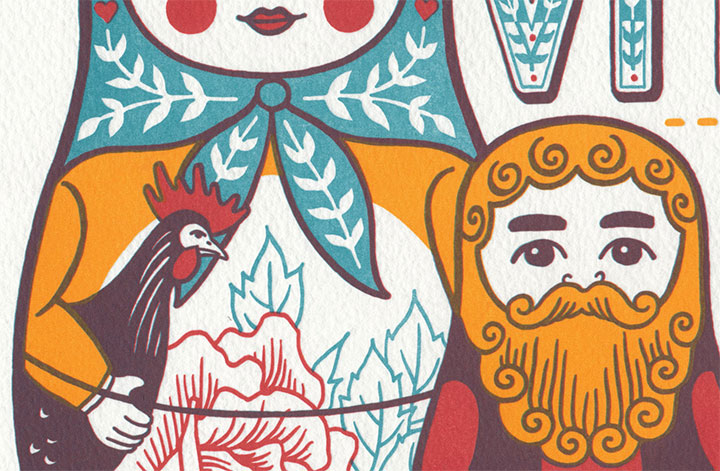
Speaking of chickens, there’s another tribute hiding in here—a nod to the very first matryoshka doll ever made.
This might well be the most difficult piece we’ve tackled yet. Beyond the challenges of marrying (no pun intended) the views of a 19th-century fringe activist to modern-day social issues, we also had some seriously precarious business on the technical side. Those of you who are into the nitty gritty details of letterpress may know that each print color requires a separate plate, a separate pass on press. We’ve got four colors in the final result, but because of the tricky magic of translucent inks, there’s actually only three plates/three passes here. The red and teal mix to make brown—which means that the registration (alignment) of each plate had to match up just right.
I was expecting Jessica to throttle me when I showed her the color separations, but as usual, she barely even batted an eye: “Yeah, we can do that.”
Or maybe she just knows me so well now that she’s expecting the crazy.
• • • • • • • • • • • • • • • • • • • • • • • • • • • • • • • • • • • • • • • • • • • • • • • • • • • • • • • • • • • •
Love Nest: No. 15 in the Dead Feminists series
Edition size: 126
Poster size: 10 x 18 inches
Printed on an antique Vandercook Universal One press, on archival, 100% rag (cotton) paper. Each piece is numbered and signed by both artists.
Colophon reads:
Emma Goldman (1869 – 1940) was born in Kovno, part of the Russian Empire (now Lithuania). She moved to New York in 1885 to live with relatives, supporting herself with factory work. In the following year, news of the Chicago Haymarket riot changed Goldman’s life. In honor of the riot victims and the labor movement, she determined to “dedicate myself to the memory of my martyred comrades, to make their cause my own.” She joined Alexander Berkman—another Russian immigrant—in spreading her vision of an ideal society, based on the anarchist principle of absolute freedom. Goldman founded the political and literary journal “Mother Earth,” and toured the country speaking about anarchism, birth control and economic freedom for women. She was arrested numerous times over her unconventional opinions, accused of disseminating illegal information and inciting to riot.
At a time when even her fellow anarchists questioned her support of homosexuality, Goldman spoke out: “It is a tragedy, I feel, that people of different sexual type are caught in a world which shows so little understanding … and is so crassly indifferent to the various gradations and variations of gender.” She openly opposed U.S. entry into WWI, was jailed once more for obstruction of the draft, and finally deported back to Russia under the 1918 Alien Act. She spent the rest of her life in exile, supporting anarchist causes abroad. After her death, Goldman’s body was repatriated and buried in Chicago—near the Haymarket anarchists that had so inspired her.
Illustrated by Chandler O’Leary and printed by Jessica Spring, who with Goldman “demand freedom for both sexes, freedom of action, freedom in love and freedom in motherhood.”
UPDATE: poster is sold out. Reproduction postcards available in the Dead Feminists shop!

June 6th, 2012
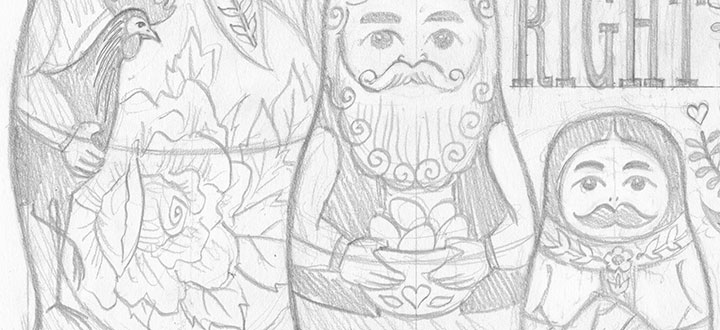
Our new Dead Feminists broadside is coming next week! We’re still printing, which is proving to be a bit of a sticky wicket (as you’ll see), but here’s a snippet for now. Any guesses?
May 20th, 2012
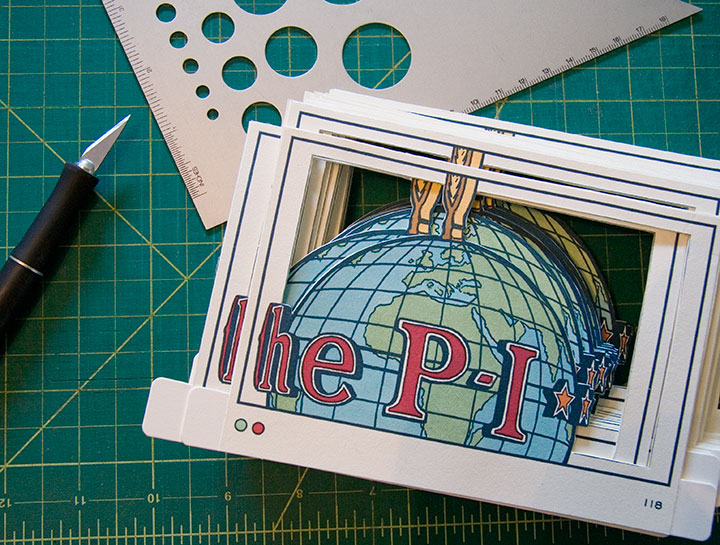
Now that I’m back in town, I’ve got deadlines. Lots of them.
Like, hundreds and hundreds. Each one shaped like a little P-I Globe, a little Space Needle, or any number of things.
You get the idea.
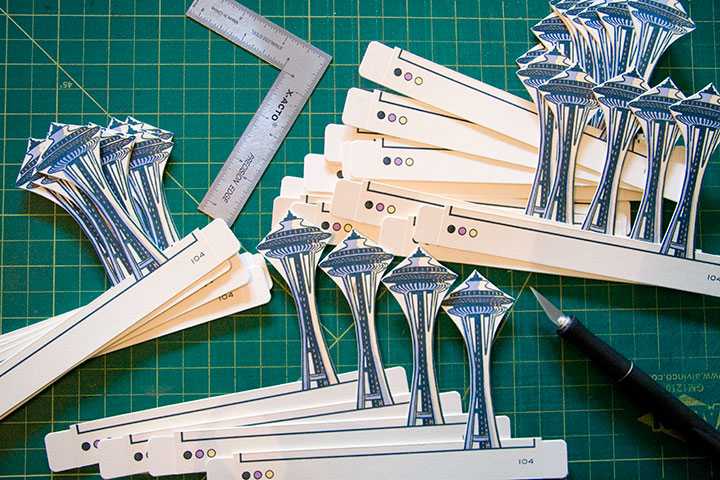
April 23rd, 2012
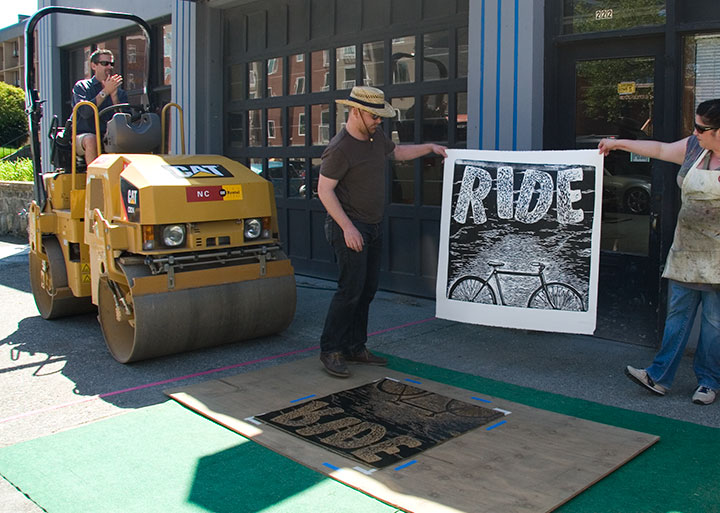
Oh, man. I’m beat. You people plum wore me out this time. Every year I keep thinking we can’t possibly top the previous one, but Wayzgoose just keeps getting better and better. And this year, the weather was so unbelievably good* that I think half of Tacoma (plus a good portion of Seattle and a smattering of Portland) put on their walking shoes and marched into our midst.
*See all those pairs of sunglasses? That straw hat? You don’t see those much ’round these parts. We’re the pasty-rainy vampire people, remember? Sunshine in April = naw, son, you must be dreaming.
To put it another way: it was absolute crazy sauce.
Or maybe it was just that the word is fully out now about our little printers’ party. After all, the Weekly Volcano said last week, “There are otherwise button-down, Wonder-bread, vanilla South Sounders who lose their ever-lovin’ shizz over Wayzgoose.” Amen, bros.
Big thanks to everyone who showed up to the party (even if I didn’t get a chance to thank you in person); to the Tacoma Arts Commission for being our fairy godparents; to the small army of adorable volunteers who kept everything chuggin’ along; to Rosemary Ponnekanti at the News Tribune for the write-up; to Kyle Durrie for making an appearance in her travelin’ Type Truck; and to sweet pea Flaherty and Jessica Spring for making it all happen.
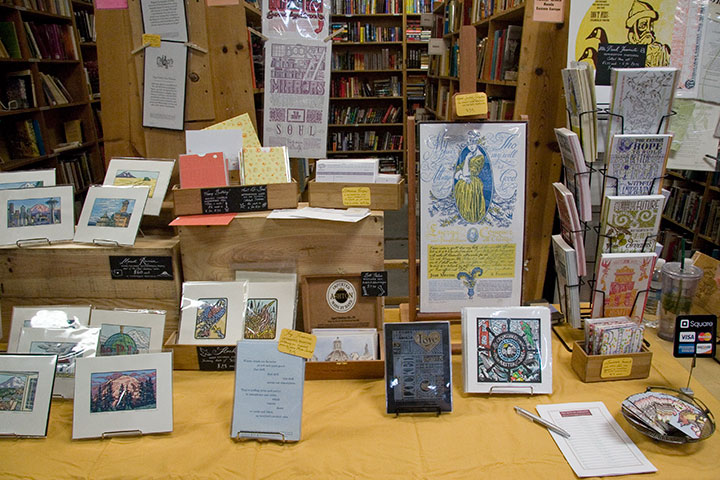
Speaking of Jessica, I think I laid eyes on her all of twice, all day. She was scurrying around and herding cats outside, while I was camped behind a steady stream of folks at our adjacent tables (thanks, y’all!). There wasn’t even room to sneak a hip shot of how many people were shoehorned in there, so the only photos I could snag were right at the beginning before folks showed up, or at the end, when people finally started to clear out.
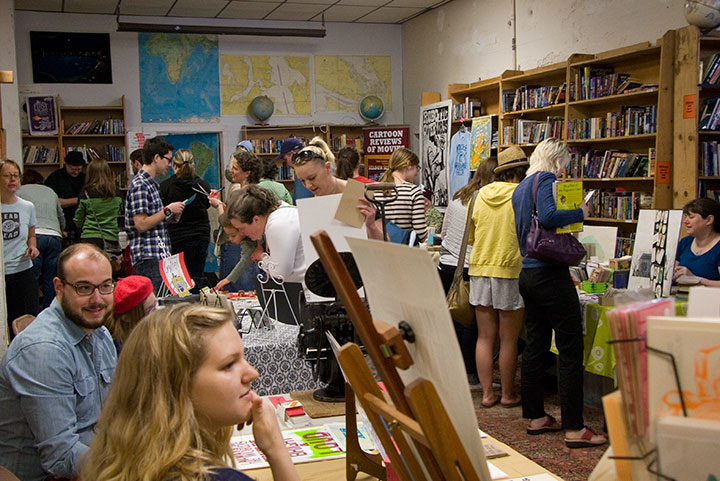
I know this doesn’t look like a big crowd, but trust me—it was a total sardine can in there. (Or clown car, if you prefer circus metaphors. I know I do.) But when the room is packed with all your favorite Northwesterners, it’s a win-win.
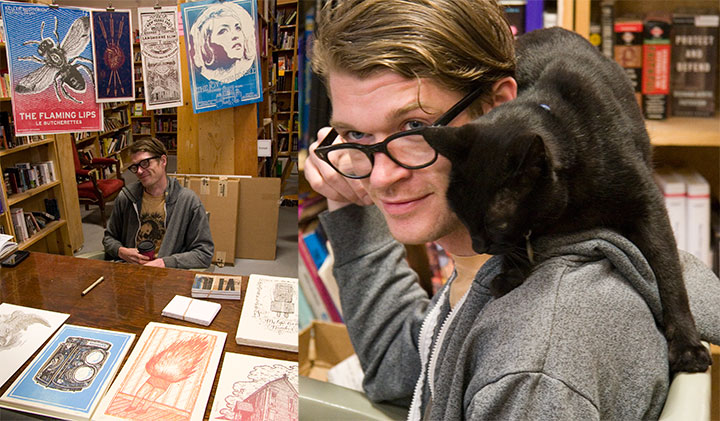
Among the talented regulars was my lovely friend Keegan (and of course, Atticus, who frequently thinks he’s a pirate parrot. Yarr!).
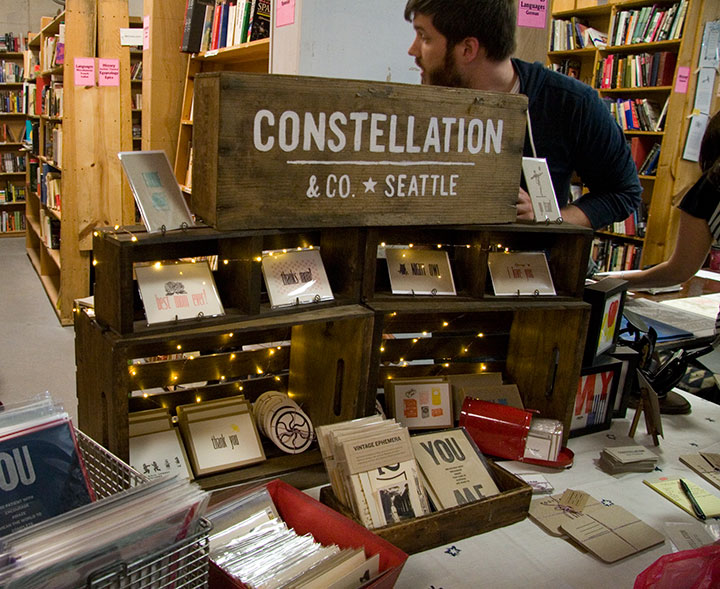
There was also a very special newcomer this year. My former student Sara caught the letterpress bug, and caught it bad. In less than three years since she took my class, she and her husband Brad (pictured) have gone from newbie nestlings to fully-fledged, successful business owners. Sigh. My kids are all grown up and making a hand-printed ruckus! It does my heart good.
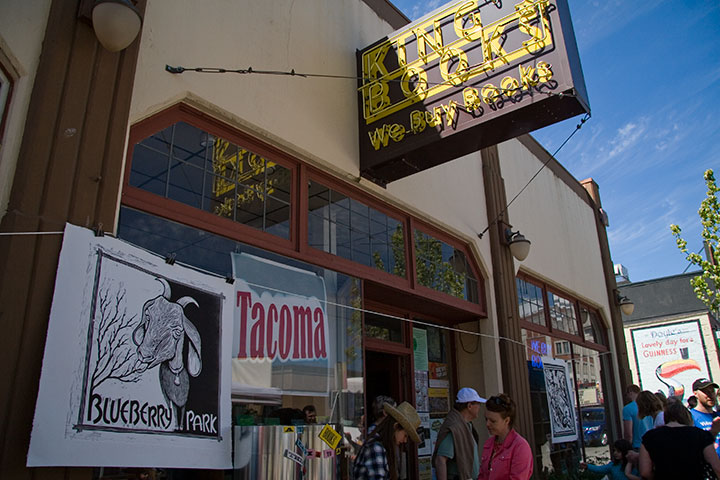
Outside, the steamroller prints were better than ever. (Special shout-out to Audra Laymon for her goatey Blueberry Park print! I think a hundred people heard me squeal when I saw it.)
Jessica and I decided to sit out the steamroller this year to make room for a few new folks, and that turned out to be a smart move. Just standing at my table for six+ hours hobbled me like an arthritic old woman—I don’t think my knee would have been up to printing. My only regret was not being able to witness much of the spectacle this year.
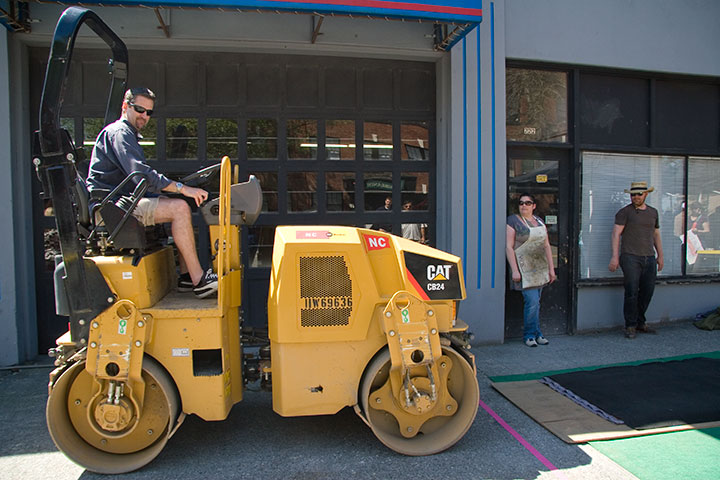
I did sneak outside long enough to learn that Tacoma’s own Arts Commissioners had been pressed into service (heckuva job, Scott!)—
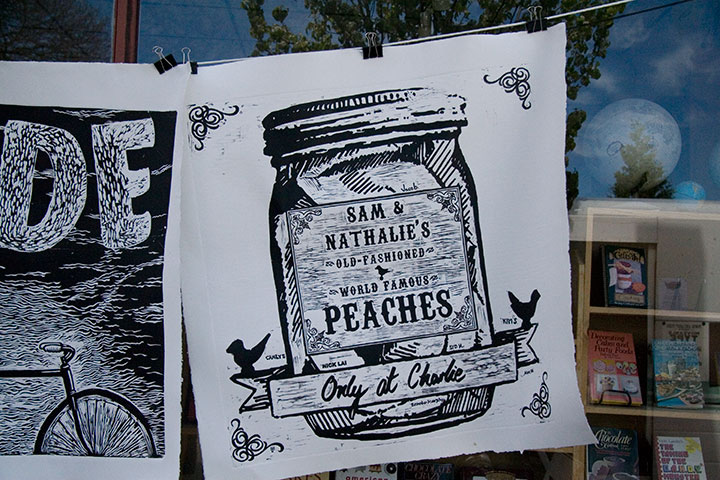
and that the print quality was the tastiest it’s ever been, thanks to some tweaked techniques Jessica gleaned from our day in San Francisco last fall.
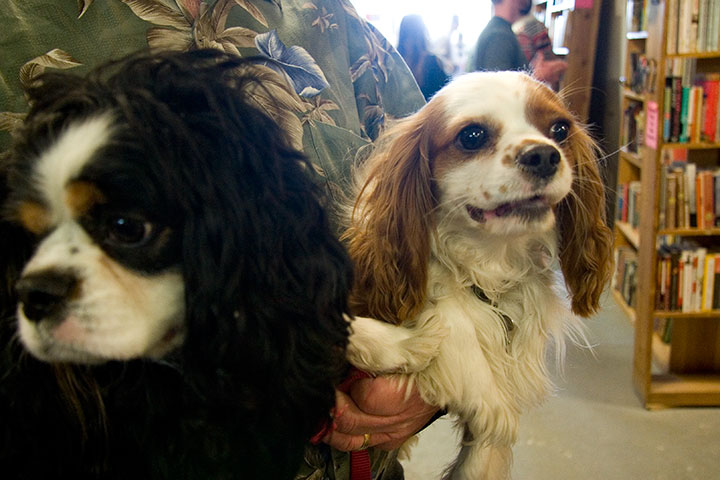
Attendance reached a new record this year—I think we’re an official Tacoma institution now. Mr. sweet pea says the count of men, women, children, babies and beasties approached the 1,000 mark!
(R.J. says: Word to your mother.)
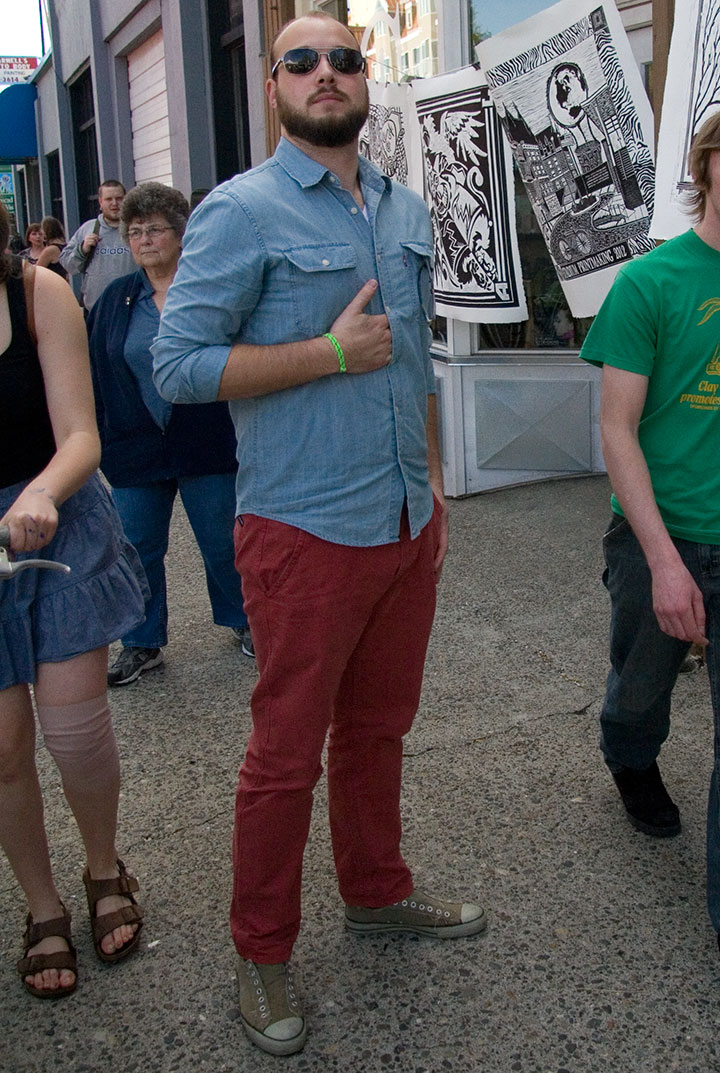
April 9th, 2012
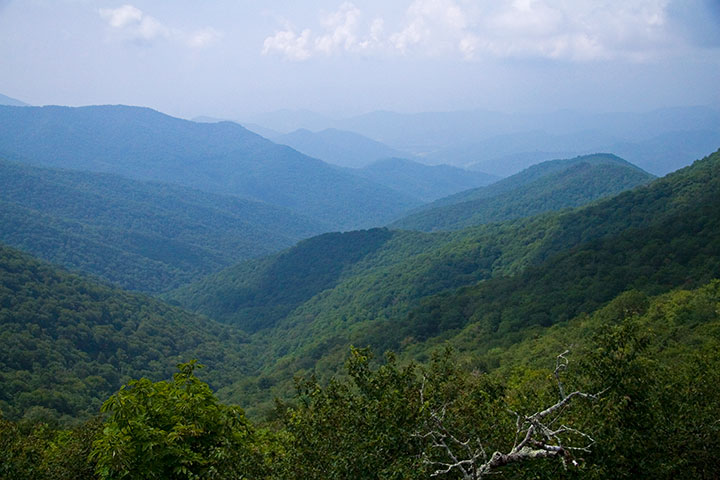
When Jessica and I were in North Carolina last summer, we had just enough sightseeing time to squeeze in a short trip along the aptly-named Blue Ridge Parkway.
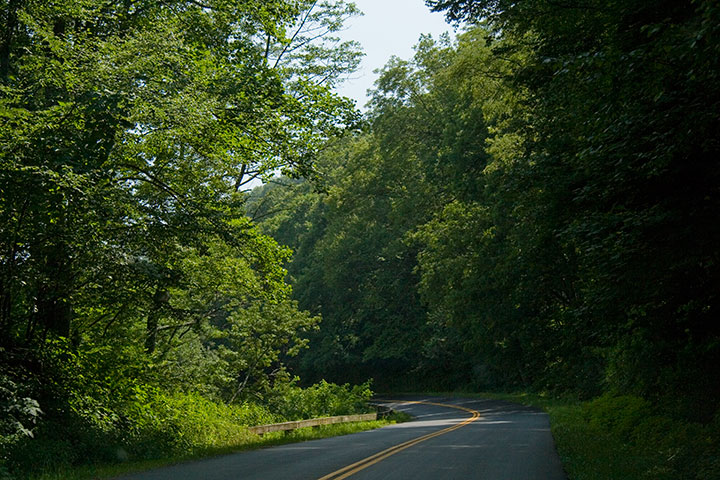
Between the dappled sunlight,
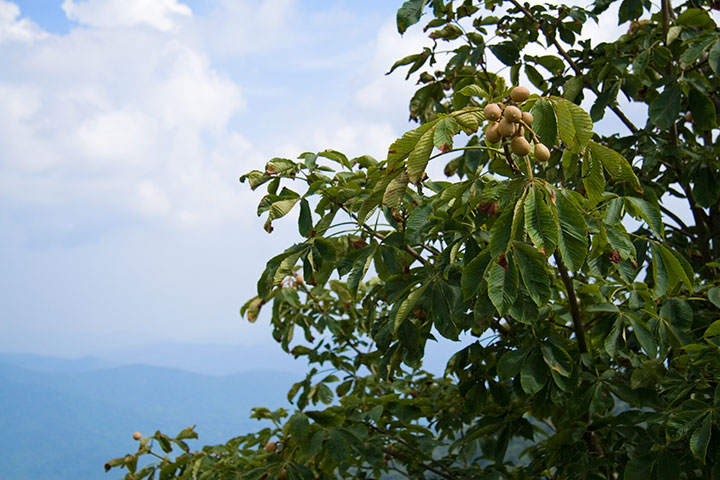
the lush Southern greenery,

and the unexpected splashes of color,
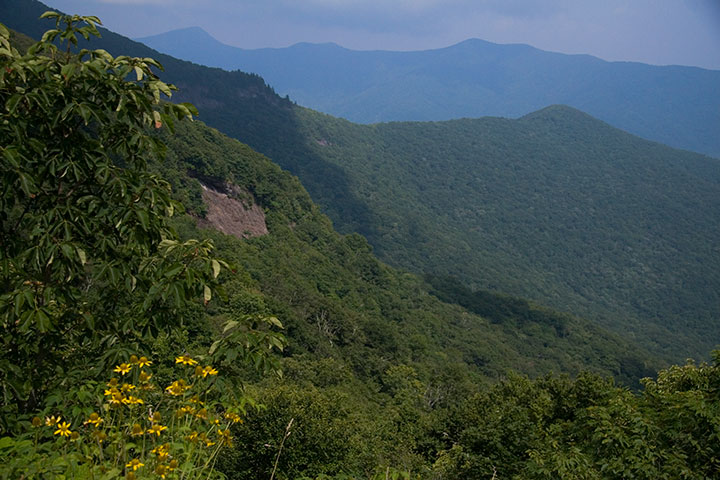
we were enchanted in an instant.
(I, for one, was tempted to do a little Katniss Everdeen impression—just run away from it all and head for the hills.)
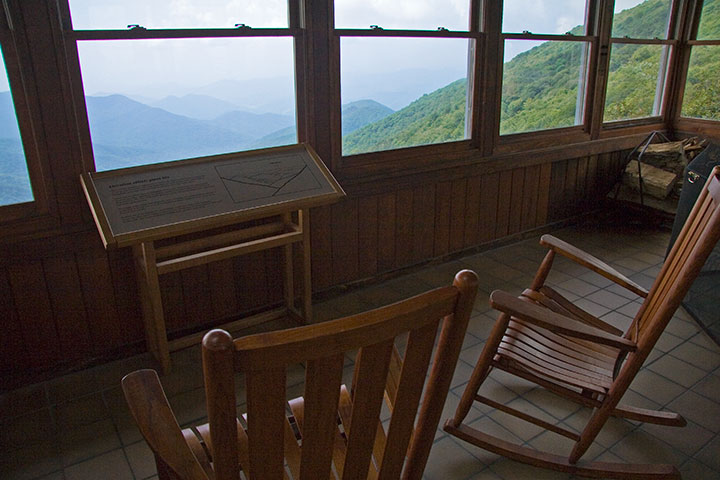
It wasn’t hard to imagine sitting down and breaking out the paper and paints, with all that blue haze as inspiration.
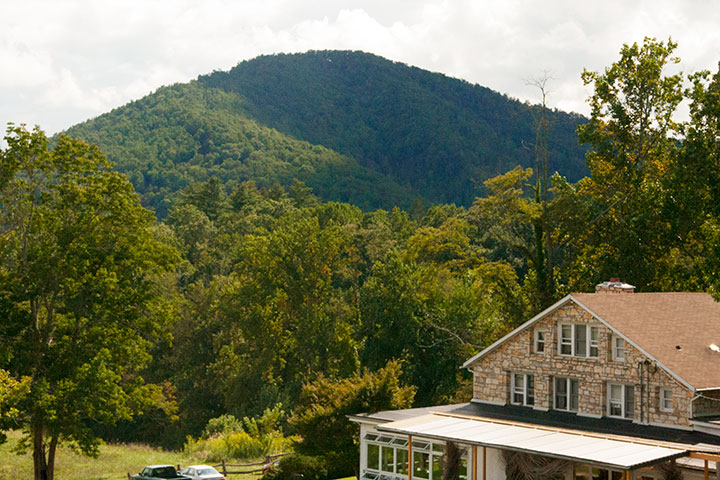
The folks at the nearby Penland School of Craft certainly agree. Since Lucy Morgan founded it in 1929, Penland has become a national center for craft education. Widely respected for its preservation of handcraft traditions, Penland is centered on total-immersion study and both traditional and experimental techniques. Settled in a quiet pocket of the Blue Ridge Mountains, it’s an inspiring setting for focused work. Thanks to its reputation and location, the school attracts some of the country’s best artists and fine craftspeople to study and teach in the Penland studios.
So you can imagine how thrilled and honored Jessica and I were when they asked us to come and teach a letterpress workshop there this summer.
We’ll be teaching a one-week printing intensive, and doing our very best to turn the printshop upside down. This ain’t your grandpa’s letterpress. Here are the details:
Letterpress: Old Dog, New Tricks
A printmaking intensive with Chandler O’Leary and Jessica Spring
Penland School of Crafts, Penland, NC
Summer Session 7: Aug. 26 to Sept. 1, 2012

In the class, we’ll work with both hand-set type (don’t worry, we won’t monkey with any linotype machines…) and photopolymer plates to produce editioned prints that combine the two techniques.
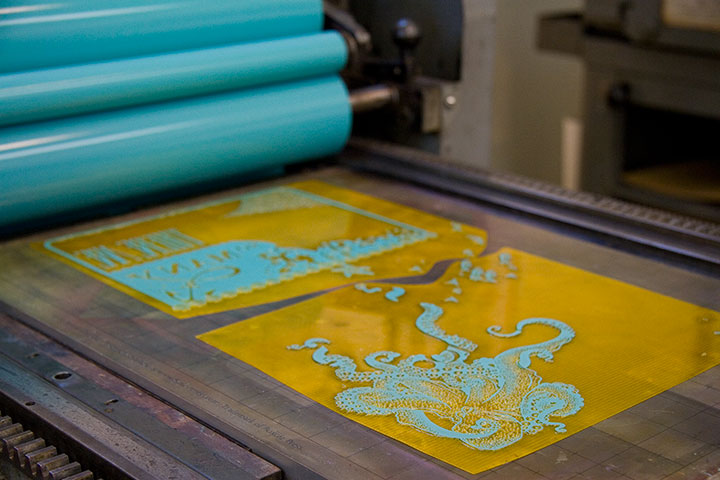
We’re going to get pretty technical, pretty fast, but don’t worry—the workshop is open to all levels of experience. That way we can bring letterpress newbies up to speed quickly, and give more experienced printers the chance to go nuts and geek out with us.
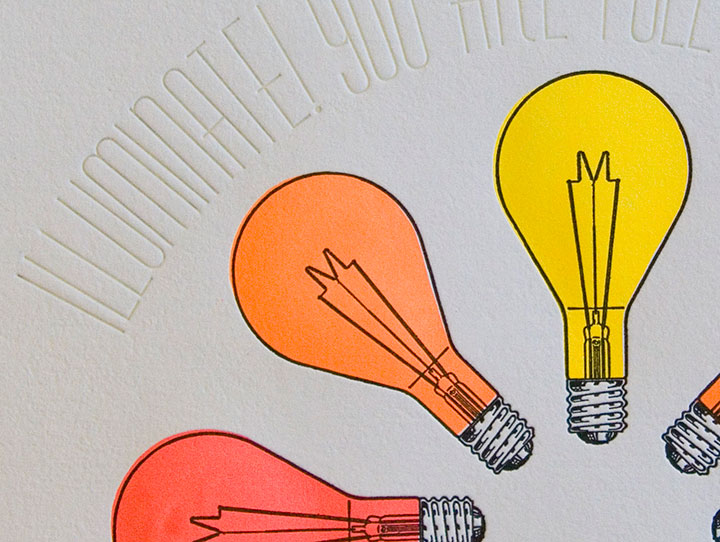
“Unnatural Light” by Jessica Spring
You’ll be doing some death-defying typesetting by hand, using Jessica’s acrobatic techniques,
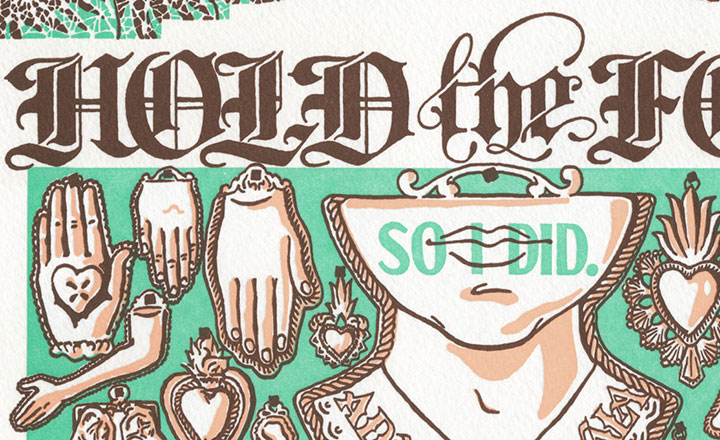
On a Mission Dead Feminist print
and I’ll teach you the ropes of designing for photopolymer, so you can throw a three-ring hand-drawn circus into the mix.
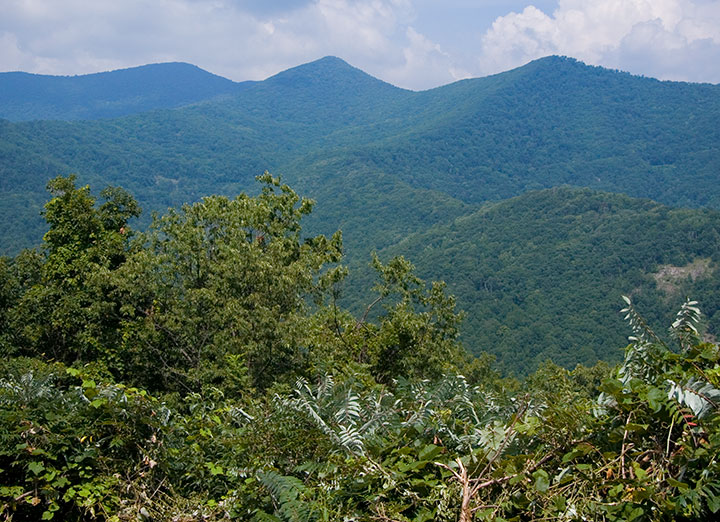
So get thee to the mountains and join us! Registration is open now, but don’t wait too long—the class is capped at 12 students.
See you in North Carolina! Save me some grits, will you?
April 4th, 2012
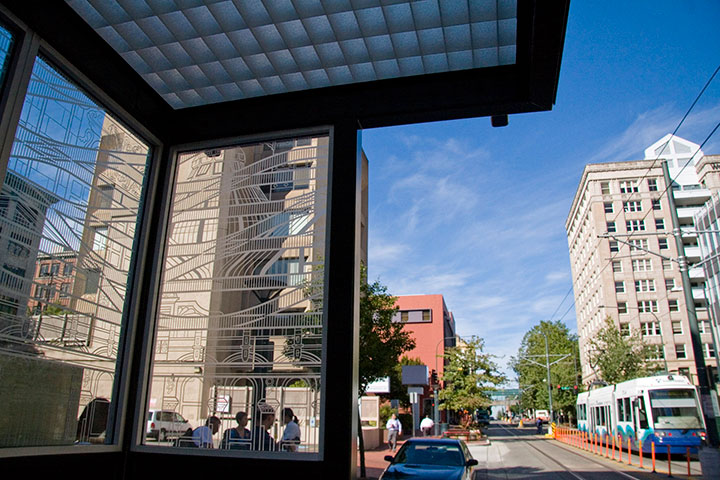
This is rather old news now, but as it took such a long time to complete, and as it isn’t exactly going anywhere, being hot off the press doesn’t matter so much. Last year I was commissioned to do a piece of public artwork here in Tacoma, and as of a few months ago, the Commerce Street light rail station is up and running.
I’ve done several temporary and permanent public pieces before, but this was my first commission for a durable materials project—and by that I mean materials that can be expected to last many decades with minimal maintenance (metal, stone, concrete, ceramics, glass, etc.). Interestingly, painted murals are not considered durable; they require all kinds of upkeep, and have an average life expectancy of only five to ten years.
The Commerce Street Station project called for a design for etched glass. Now, as you’re well aware, I’m no glass artist—it’s a little weird to think of a letterpress printer doing glass work. But that’s the beauty of the public art realm: instead of one artist tackling every aspect of a project, there’s a whole team of people involved, each focused on his or her particular strengths. I was responsible for the design, and industrial fabricators took care of the actual glass-etching part. So what my part boiled down to was a process nearly identical to what I do for any letterpress print: a hand-drawn illustration, converted into a computer file for production. Realizing that created a huge mental shift for me, and suddenly made the prospect of wearing a Public Artist hat way less intimidating.
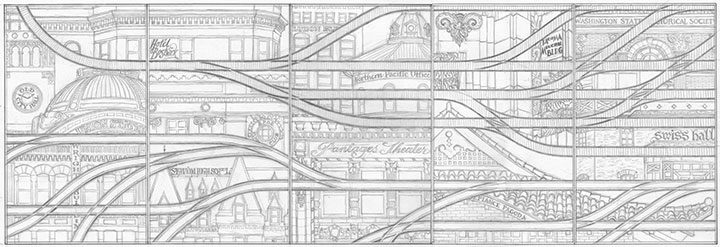
If you’ve ever stood in a shelter waiting for a bus or train, you’ve probably seen an etched glass design. Usually it’s an abstract pattern to discourage graffiti, or in the Pacific Northwest, often something outdoorsy or salmon-themed. So I figured that territory was well covered. Instead, I focused on the rails themselves. The railroad is possibly the single most significant aspect of Tacoma’s history; it is truly the backbone of our city. In 1873, Tacoma was chosen over Seattle as the terminus of the Northern Pacific Railroad. Without the resultant growth and industry that resulted from the railroad hub, Tacoma might still be a tiny fishing hamlet, rather than a bustling port.
For decades, industrial and passenger rail travel was our pride and joy. Along with the goods and people moving along the NP Railroad line, Tacoma was also criss-crossed with streetcar lines, providing efficient and comprehensive public transportation. During the Great Depression, however, the cost of maintaining the streetcar lines became too heavy a burden. The system was dismantled in 1938, and private automobiles became the dominant mode of transportation. This story is by no means unique — passenger rail fell out of favor all over the country, and today, public rail transit is only the norm in our largest cities.
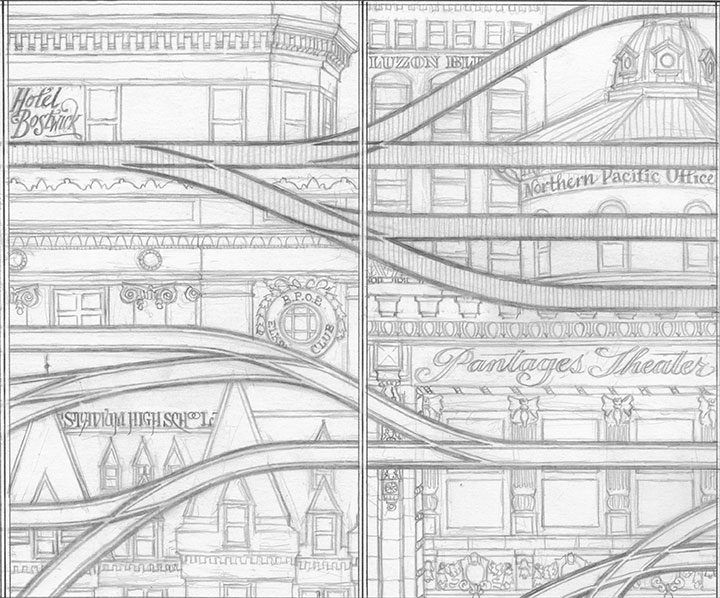
To me, our small (but expanding) light rail line is a ray of hope for a progressive future, a return to a more sustainable system, and a chance to highlight Tacoma’s history. So for Continuum, I designed a brace of parallel rail lines. The top line is a set of traditional railroad tracks, beginning as a single thread and branching outward—symbolizing Tacoma’s beginnings and expansion. The bottom tracks are grooved-rail embedded tram tracks—exactly the type you see in both old streetcar lines and modern light rail paths. As the traditional tracks branch outward, the tram tracks converge into a single path, just as our lone light rail line is the last vestige of the old streetcar network.
Tacoma’s architecture sprouted and developed right alongside the railroad, as a result of our industrial growth. So instead of surrounding the tracks with a white-noise pattern of ballast, like you’d see around real tracks, I designed an illustrated amalgam of our most iconic buildings. Some are still with us; others are long gone (can you spot the Luzon Building above?). Every structure represented exists either along a historic streetcar or other track line, or has some connection with the railroad.
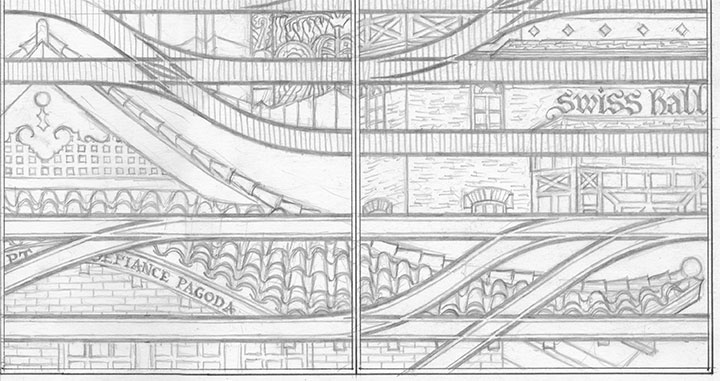
While I was working on the initial design, a teenage arsonist set fire to the historic Pt. Defiance Pagoda. Suddenly it didn’t seem to be enough for the city merely to preserve the architecture—I felt the need to create my own record of as many buildings as I could.
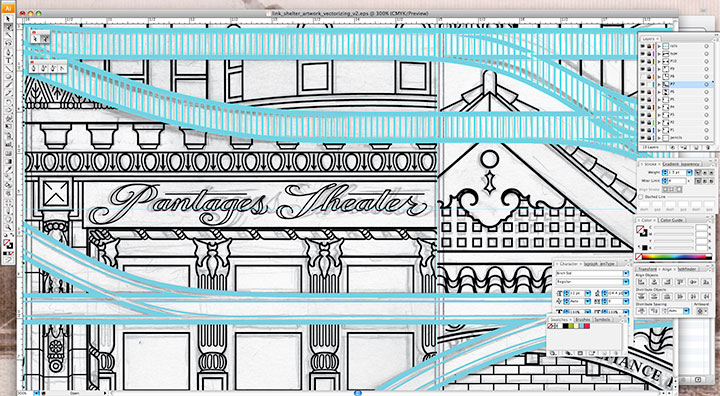
My pencil drawings weren’t finished enough to send to the fabricator—I needed to bridge the gap between my pencil and their equipment. To get the artwork to the point where it could be etched into glass, I needed to convert it to a specific file format called vector graphics. Now, digital photos are made up of pixels: a grid of tiny dots that determine how large a size an image can be blown up to be. The more pixels per square inch, the larger you can make the photo. Vector art doesn’t work like that. Without getting in over my head in explaining this, vector graphics are made of math.
(Which is super cool, really.)
The shapes are determined by geometric points, lines and proportions, rather than pixels. So that means you can blow the artwork up to any mammoth size, or shrink it as small as you please, and you’ll never lose detail or image quality. This makes the vector format A) awesome; and B) ideal for translating extremely intricate work into industrial materials. All I had to do was fire up Adobe Illustrator, and get to work converting the artwork.
This took days. And days. And days.
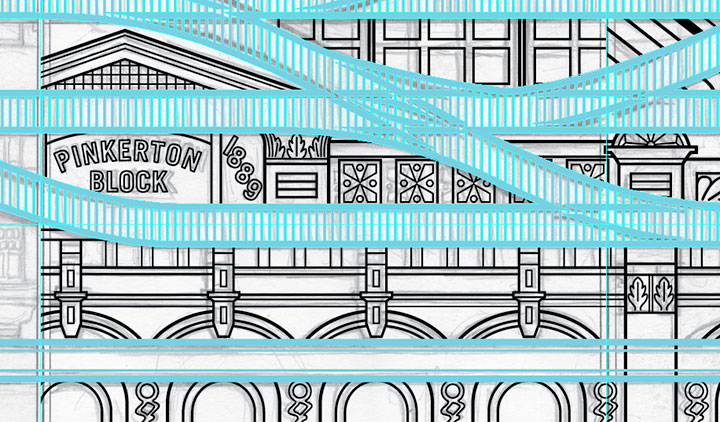
It’s funny that people tend to see computer programs as shortcuts or “cheats,” but in the end, any good piece of digital artwork requires a level of craftsmanship—exactly the way a handmade object does. Illustrator has lots of labor-saving tools if you know where to look, but the ones that are designed to fully automate the conversion from a scanned drawing to a vector file aren’t always ideal. For this particular project, the only way to do it right was to suck it up and spend ungodly hours redrawing the thing “manually” within the program. I had to rely on all my artist chops just as much for file production as I do for any artist book or watercolor painting. I easily spent as much time converting the design to vector format as I did drawing it by hand, but it’s important to have a flawless file—lots of expensive production steps are dependent upon that file being free of glitches or stray marks.
As an aside, one night that I stayed up (very) late working on the file happened to be the night of the Royal Wedding. To provide some background noise (in order to stay sane), I streamed the event in a little window on the corner of my screen while I worked. So now, whenever I see the finished glass panels I think of ridiculously ornate English hats, and the Queen in her vanilla Jello pudding-colored suit. Pavlov would have a field day with me.
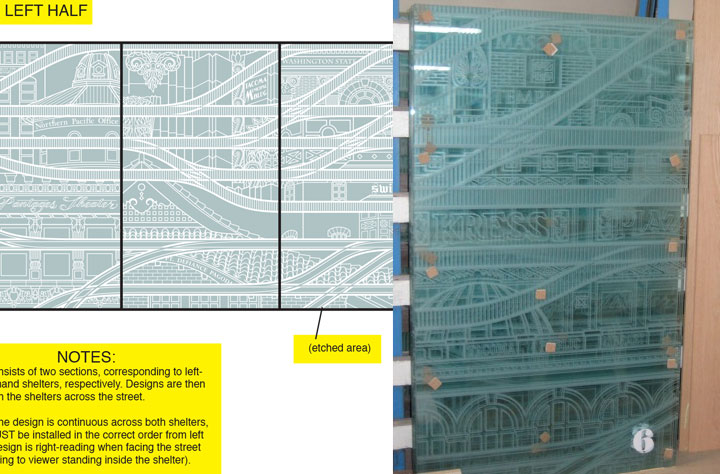
Right-hand photo courtesy of City of Tacoma
Anyway, next I sent the finished files to the fabricator. Using the points plotted in the file, and a digital mockup I threw together with my production notes, they were able to cut the design out of a masking material, which they attached to the glass. Then the sand-blasted the glass panels. Where there were holes cut through, the sand made contact and etched the glass; everything protected by the mask stayed shiny and transparent. The finished result is a clean, precise replica of my design.
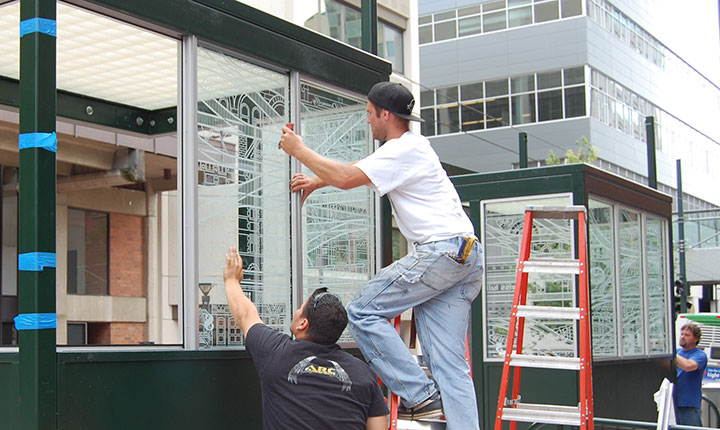
Photo courtesy of City of Tacoma
The tricky part was making sure they installed all ten panels in the correct order; otherwise the connecting track lines wouldn’t make sense. Thanks to the big fat numbers they stuck to each panel, though, everything worked out just fine.
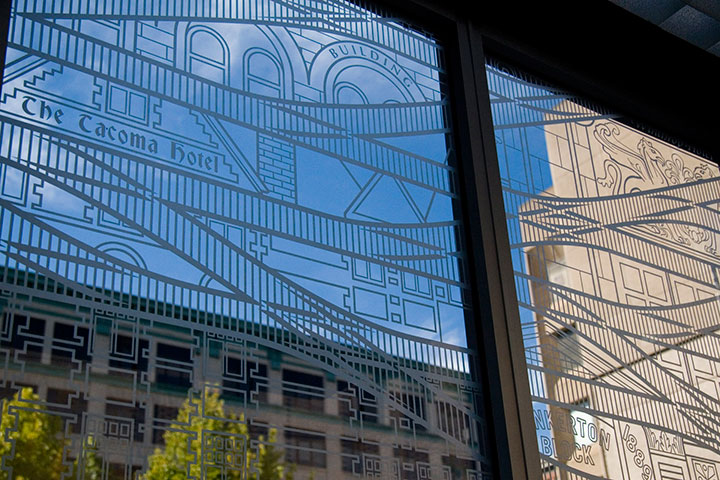
It’s fun to stand inside the finished shelter, and see the stylized buildings contrast with real ones. And when you’re not paying close attention to the details, the illustrations recede into a sort of geometric pattern.

For those who are paying attention, my hope is that this little illustrated city will encourage viewers to notice the real city around them—preferably with an eye toward preservation and innovation.
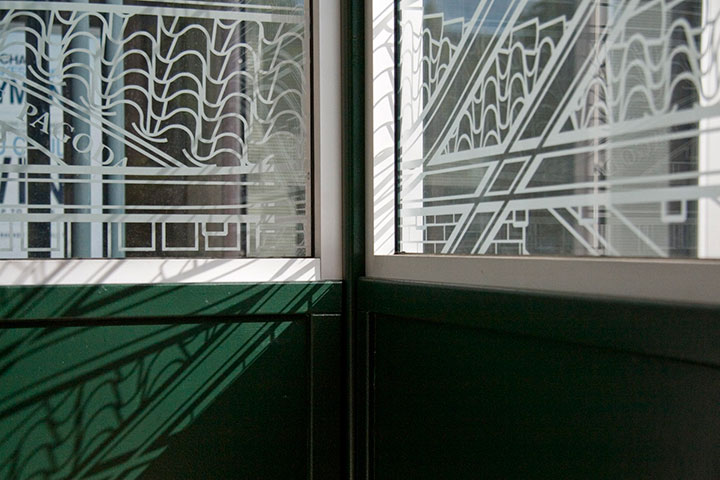
Attentiveness has its own little reward, too. If you happen to be there when direct sunlight hits the glass, the etched lines project onto every surface. (Tacoma looks good on you.)
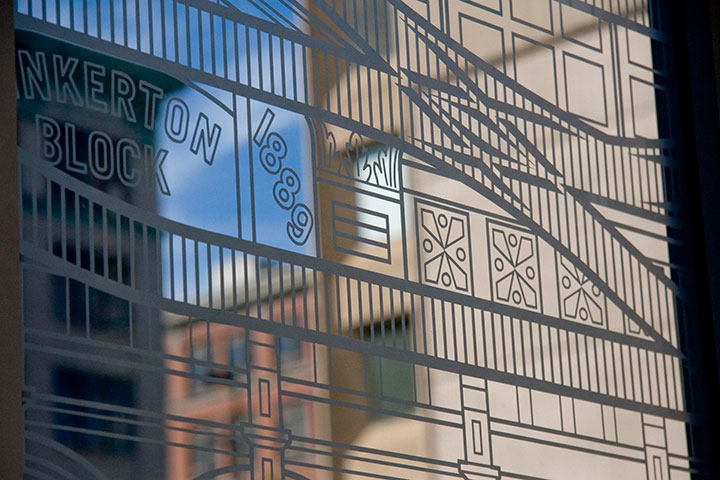
In the end, I just wanted to take the dull routine of waiting for a train, and turn it into something beautiful—even if only for a moment.
I’m always saying things like, “If I ran the world…”, usually followed by some crazy idea for transforming every mundane thing in life into something a little more meaningful. I love the thought that on one tiny patch of real estate, I really did get to run the world, and make things exactly the way I imagined they could be. Many thanks to Amy McBride and the City of Tacoma for giving me free rein.
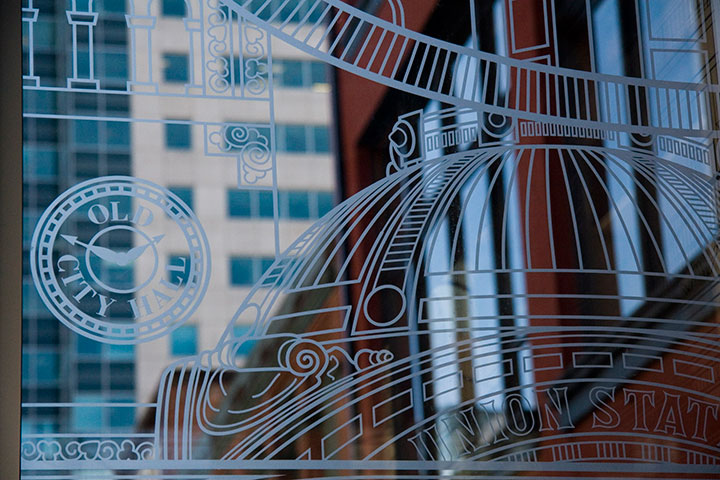

![Chandler O'Leary [logo]](https://chandleroleary.com/wp-content/themes/chandleroleary/images/logo.png)

























































